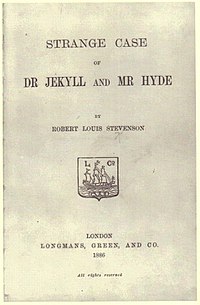Strange Case of Dr Jekyll and Mr Hyde is the original title of a novella written by the famous Scottish author Robert Louis Stevenson that was first published in 1886. The work is commonly known today as The Strange Case of Dr Jekyll and Mr Hyde, Dr Jekyll and Mr Hyde, or simply Jekyll & Hyde.[1] It is about a London lawyer named John Gabriel Utterson who investigates strange occurrences between his old friend, Dr Henry Jekyll,[2] and the evil Edward Hyde.
The work is commonly associated with the rare mental condition often spuriously called "split personality", where within the same body there exists more than one distinct personality.[3] In this case, there are two personalities within Dr Jekyll, one apparently good and the other evil; completely opposite levels of morality. The novella's impact is such that it has become a part of the language, with the very phrase "Jekyll and Hyde" coming to mean a person who is vastly different in moral character from one situation to the next.[3][4]
Contents [hide]
1 Reception
2 Inspiration and Writing
3 Characters
3.1 Dr Henry Jekyll / Mr Edward Hyde
3.2 Dr Hastie Lanyon
3.3 Mr Gabriel John Utterson
3.4 Poole
3.5 Richard Enfield
3.6 Inspector Newcomen
3.7 Sir Danvers Carew
3.8 A Maid
4 Plot
5 Analysis
6 Adaptations
7 References
8 Bibliography
9 External links
[edit]Reception
Strange Case of Dr Jekyll and Mr Hyde was an immediate success and is one of Stevenson's best-selling works. Stage adaptations began in Boston and London and soon moved all across England and then towards his home Scotland [5] within a year of its publication and it has gone on to inspire scores of major film and stage performances.
The Strange Case of Dr Jekyll and Mr Hyde was initially sold as a paperback for one shilling in the UK and one dollar in the U.S. The American publisher issued the book on 5 January 1886, four days before the first appearance of the UK edition issued by Longmans; Scribner's published 3000 copies, only 1250 of them bound in cloth. Initially stores would not stock it until a review appeared in The Times, on 25 January 1886, giving it a favourable reception. Within the next six months, close to forty thousand copies were sold. The book's success was probably due more to the "moral instincts of the public" than any perception of its artistic merits; it was widely read by those who never otherwise read fiction, quoted in pulpit sermons and in religious papers.[citation needed] By 1901 it was estimated to have sold over 250,000 copies.[citation needed]
[edit]Inspiration and Writing
Stevenson had long been intrigued by the idea of how personalities can affect a human and how to incorporate the interplay of good and evil into a story. While still a teenager, he developed a script for a play on Deacon Brodie, which he later reworked with the help of W. E. Henley and saw produced for the first time in 1882.[6] In early 1884 he wrote the short story "Markheim", which he revised in 1884 for publication in a Christmas annual. One night in late September or early October 1885, possibly while he was still revising "Markheim," Stevenson had a dream, and upon wakening had the intuition for two or three scenes that would appear in the story. "In the small hours of one afternoon," says Mrs Stevenson, "I was awakened by cries of horror from Louis. Thinking he had a nightmare, I woke him. He said angrily, 'Why did you wake me? I was dreaming a fine bogey tale.' I had awakened him at the first transformation scene ..."[cite this quote]
Lloyd Osbourne, Stevenson's stepson, remembers "I don't believe that there was ever such a literary feat before as the writing of Dr Jekyll. I remember the first reading as if it were yesterday. Louis came downstairs in a fever; read nearly half the book aloud; and then, while we were still gasping, he was away again, and busy writing. I doubt if the first draft took so long as three days".[cite this quote]
As was customary, Mrs Stevenson would read the draft and offer her criticisms in the margins. Louis was confined to bed at the time from a haemorrhage. Therefore, she left her comments with the manuscript and Louis in the toilet. She said that in effect the story was really an allegory, but Louis was writing it as a story. After a while Louis called her back into the bedroom and pointed to a pile of ashes: he had burnt the manuscript in fear that he would try to salvage it, and in the process forced himself to start again from nothing, writing an allegorical story as she had suggested. Scholars debate whether he really burnt his manuscript; there is no direct factual evidence for the burning, but it remains an integral part of the history of the novella.[citation needed]
Stevenson re-wrote the story in three to six days. A number of later biographers have alleged that Stevenson was on drugs during the frantic re-write; for example, William Gray's revisionist history A Literary Life (2004) said he used cocaine, while other biographers said he used ergot.[7] However, the standard history, according to the accounts of his wife and son (and himself), says he was bed-ridden and sick while writing it. According to Osbourne, "The mere physical feat was tremendous and, instead of harming him, it roused and cheered him inexpressibly". He continued to refine the work for four to six weeks after the initial re-write.

No comments:
Post a Comment